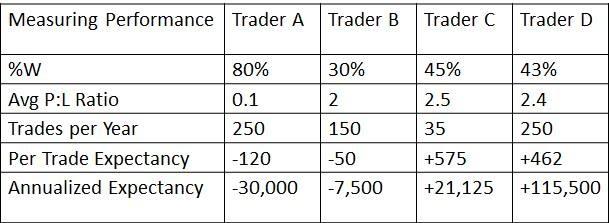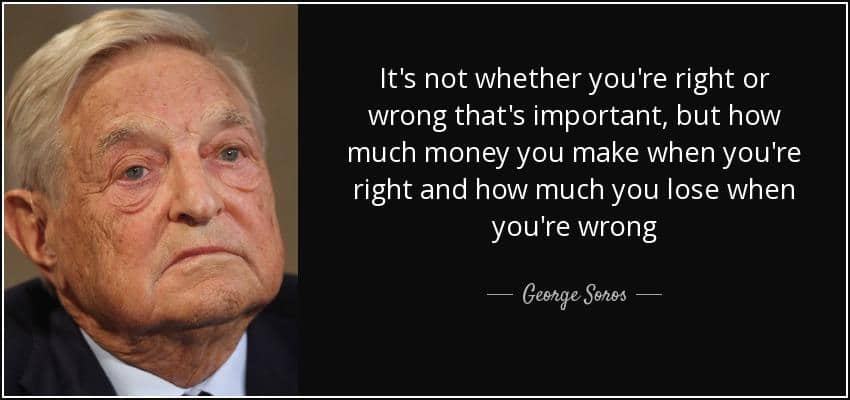The importance of expectancy in forex

One of the critical metrics regarding expectancy is the risk to reward ratios. These ratios arguably make or break a trader. Why is this important? Well, the cold, hard fact is no trader wins every single time. Research has consistently shown that most traders have decent strategies that have the potential to profit. However, what causes them to lose is where the risk is so widely disproportional to any of their winning trades that it eventually wipes them out. In other words, a negative expectancy.
The hardest part about trading is not just the real possibility of losing but also consecutive losses. Drawdowns are natural for everyone, though the only way to overcome them is by having a positive expectancy. The higher the expectancy, the easier it is to get out of drawdowns since one or two winners more than makeup for any losses incurred. In essence, expectancy grounds a trader to focus more on managing risk and aiming to have bigger winning trades than losing trades.
The most common formulas for calculating expectancy are:
- Expectancy = (winning probability X average win) – (losing probability X average loss).
- Other traders can express expectancy as a ratio. This calculation is attained by taking the multiplication of the R:R ratio and the win percentage, and subtracting the loss percentage. (Risk to reward ratio X win percentage) – loss percentage.
The deeper understanding of expectancy in forex
As a visual metaphor, we can liken expectancy in forex to poker players. There are many similarities between successful forex traders and poker players. The most successful poker players do not win every hand, and they bet their chips strategically. However, even if they do not win on every hand, the expectancy is that they come out winners by having enough chips and betting on the strongest hands over the long haul. Similarly, traders should attempt to play a numbers game where they’re taking the most reliable trade ideas and ensuring they have enough capital to trade.
The risk to reward ratios and overall expectancy should not be assumed on every trade because not every trade will provide the desirable reward. For example, some traders might say they won’t take a position if it does not have the potential to net them X reward. This type of thinking is somewhat flawed because even if you don’t lose on a trade, that doesn’t necessarily mean you will get your desired reward. Sadly, trading is not so binary. Also, no one knows with a high amount of prediction how far a market can go, further reinforcing the idea that rewards are never a sure thing.
Therefore, it’s tough to judge the potential of a trade set-up at face value, though it does not mean that you just trade willy-nilly. There has to be a firm belief in each position where you believe the trade is a good one to risk your hard-earned money on. However, one should never consider the reward a certainty majority of the time. So, the expectancy discussion is more of a guide than an absolute. The only absolute is the risk, not the reward.
The expectancy guides the trader in the long run in terms of reasonable aims. It’s possible to witness how a strategy has fared in the past, and how far trades have gone. However, in reality, the approach to trade management is a lot more nuanced. Assuming you’ve managed your risk accordingly, you have to know for how long you’re going to hold a trade if it has the potential for the reward or when it’s sluggish. These skills are easier said, but difficult to do in reality.
Evaluating the expectancy of a trading system
So, since we know that not every trade has a guaranteed reward, it is advisable to aim as high of a reward ratio as possible. The common adage, “Cut your losers short and let your winners run.” makes perfect sense. The hope is that over time, you end up with small losses, a few small winners, and a few big winners responsible for most of your equity curve growth.
The most common risk to reward ratios that we hear about in the industry is 1:1 to 1:3. However, it is possible for much higher, though it depends on the type of trader and the strategy. Generally, scalpers and day traders have a lower risk to reward ratio since they do not hold their positions for very long, aiming for quick, small profits. Swing and position size traders have much higher ratios simply because they intend to keep their positions for much longer, aiming for slower, bigger profits.
Expectancy is critical not just from a numbers perspective, but an emotional one too. Trading is a long game, and you shouldn’t be nervous with a positive expectancy. Assuming you keep your risk consistent on a trade by trade basis and you have an above-average strategy, you should expect to be profitable in the long run.
Conclusion
Two quotes by Peter Lynch and George Soros perfectly describe why understanding expectancy in trading forex is paramount.

“In this business, if you’re good, you’re right six times out of ten. You’re never going to be right nine times out of ten.”

“It’s not whether you’re right or wrong, but how much money you make when you’re right and how much you lose when you’re wrong.”
Both of these quotes reinforce two vital points.
- You can still be wrong over a large sample of trades and come out profitable.
- You have to ensure your winners outweigh your losers as much as possible, i.e., lose less when you’re wrong, win more when you’re right.
The basic formula of being profitable is small losses and big winners. This metric is not just about the risk to reward, but also the very fact that the probabilities of any trade outcome realistically are 50-50 since there are only two outcomes to any trade. The aspirations of perfect trading systems can be overwhelming, though they tend to prove fruitless since they don’t exist. Therefore, what is crucial is mastering trading expectancy.




